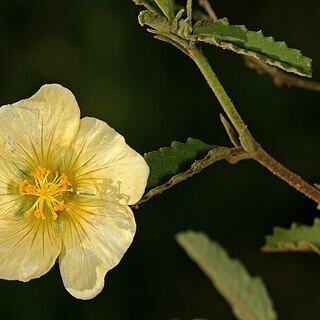Low suffrutex, 0.05-0.60 m high; stems terete, much branched at base, greyish. Leaves (lanceolate) ovate-oblong, apex subacute, base cuneate, margins coarsely serrate; upper surface dark green, lower surface greyish green, densely velutinous-tomentose. Flowers axillary, solitary; pedicels 3-6 mm long, articulated near apex. Epicalyx 0. Calyx obconical-campanulate, tomentose outside, triangularly lobed to middle, lobes acuminate with pinnately branched median vein. Petals deep yellow to orange. Flowering time summer. Fruit a schizocarp. Mericarps 7-9, truncate or subacute and stellate-hairy at apex, reticulate-veined on flat lateral sides. Seeds brown, glabrous.
Leaf-lamina 2–4 × 1–2·5 cm., usually ovate-oblong to oblong but occasionally narrower or broader, apex subacute, margin irregularly rather coarsely serrate, base generally cuneate or more or less rounded, the upper surface dark green or brownish-green, usually sparsely and minutely stellate-pubescent, glabrescent, lower surface usually much paler, greyish-or yellowish-green, densely velutinous-tomentose and with prominent veins; petiole 3–10 mm. long, tomentose-velutinous; stipules 4 × 1 mm., ovate-lanceolate to lanceolate, velutinous, sometimes somewhat falcate, rather persistent.
Perennial herb or shrub, up to 0.3(-0.6) m high; ± tomentose. Leaves with blade ± oblong, 20-40 x 10-25 mm, apex rounded to subacute, distinctly discolorous. Flowers: petals ± 10 mm long, deep yellow to orange, occasionally paler; Aug.-May. Fruit with 7-12 mericarps without 2 awns, stellate-pubescent.
Low perennial suffrutex, much branched and woody at the base, up to 30 cm., rarely up to 60 cm. tall; stems usually branched throughout, terete or somewhat angled, usually greyish-green or greyish (rarely brownish), shortly and densely tomentose-velutinous, the upper portions usually slender and wiry.
Calyx c. 8 mm. long, obconical-campanulate to saucer-shaped, tomentose outside, and along the margin inside, incised to about the middle; lobes triangular, somewhat narrowed or acuminate at the apex, 5 mm. broad at the base, with the median vein pinnately branching at about the middle of the lobe.
Perennial herb or shrub, up to 300 (rarely 600) mm tall. Leaves oblong, rounded to subacute at apex, distinctly discolorous. Mericarps without 2 awns, stellate-pubescent. Flowers deep yellow to orange, occasionally paler.
Flowers deep yellow to orange, occasionally paler, solitary, axillary; pedicels 3–6 cm. long, slender, terete, velutinous or tomentose, articulated near the apex.
Mericarps 7–9, c. 4 × 3 mm., muticous or subacute at the apex, usually stellate-hairy at the apex only, reticulate-veined on the flat lateral sides.
Seeds brown, glabrous except for a small tomentose area around the hilum.
Petals c. 10 × 8 mm., finely pubescent outside with simple hairs.
Staminal tube with stellate hairs (usually sparse).

